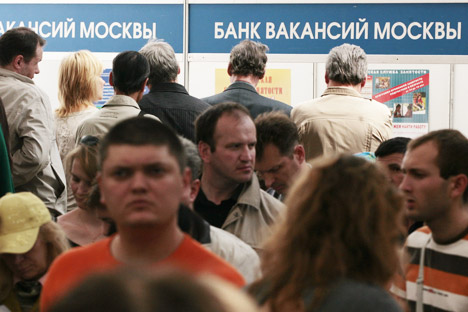Russian unemployment reaches record low

Russia's Ministry of Labor does not anticipate any upheavals on the Russian labor market, even in the event of another global economic crisis. Source: ITAR-TASS
In August of this year, overall unemployment in Russia dropped 15.3 percent, as compared to August 2011. By early September 2012, just under 4 million people (5.2 percent of the labor force) were looking for work, according to analysts at Rosstat. These findings were based on opinion polls taken by the International Labor Organization.
“This represents an historic low,” said Andrei Korovkin, head of the labor resources forecasting laboratory at the Russian Academy of Sciences’ Institute of Economic Forecasting. “The previous Russian record was established in May 2008 and comprised 4,097,000 people.” Leading expert Igor Polyakov at the Center for Macroeconomic Analysis and Short-term Forecasting remarked that an even lower figure was most likely reached in 1993, but, at the time, the center was having difficulties with its method of evaluation. Therefore, the August 2012 showing will be considered the record.
“Unemployment simply cannot drop any lower — this is its natural minimum,” said Korovkin. However, the analyst does not see anything good in such a low level of joblessness: “This means that companies are not rushing to modernize their production and increase their labor productivity. Consequently, in the future, the labor market may suffer a new shortage of workers.”
In Korovkin’s opinion, Russian unemployment will soon see the usual seasonal spike, but the average annual indicator will match that of the pre-crisis years of 2007 and 2008. If his institute forecasted unemployment for 2012 at 5 million people at the beginning of the year, then it currently anticipates an average annual showing of 4.5–4.8 million — given that this fall’s seasonal increase in unemployment is insignificant.
“Unemployment always goes up in the fall: if not in September, then definitely in October,” said Polyakov. He noted that employment, for example in the manufacturing sector, hardly grew at all this year. Meanwhile, the bad harvest in agriculture will result, in his opinion, in a seasonal drop in employment in the processing sector and in transportation. According to Polyakov’s calculations, Russian unemployment should be around 5.7 percent in the fourth quarter of 2012 and increase in the first quarter of 2013 to nearly 5.9 percent.
Nonetheless, Russia’s Ministry of Labor does not anticipate any upheavals on the Russian labor market, even in the event of another global economic crisis. In order to regulate employment and provide social benefits to those people who have lost or will lose their jobs, the government plans to spend 594.7 billion rubles (some $20 billion) between 2013 and 2020, including 529 billion rubles from the federal budget.
In August, the level of unemployment in the United States was 8.1 percent, while in euro-zone countries it reached another record high — 11.3 percent. The average showing for overall unemployment in the European Union was 10.4 percent. The highest level of unemployment was found in Spain (25.1 percent), and the lowest in Austria (4.5 percent). By comparison: unemployment in France was 10.3 percent, in Great Britain 8 percent, and in Germany 5.5 percent.
First published in Russian in Vedomosti.ru.
All rights reserved by Rossiyskaya Gazeta.
Subscribe
to our newsletter!
Get the week's best stories straight to your inbox